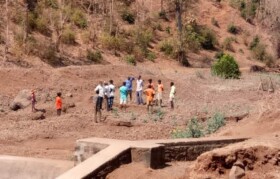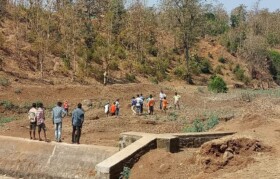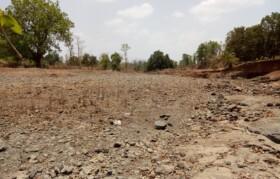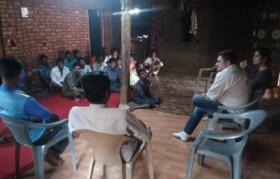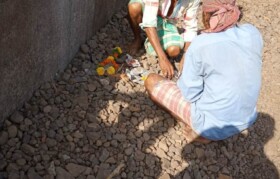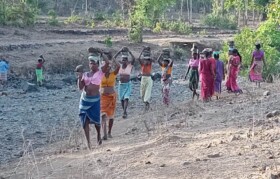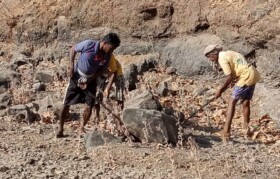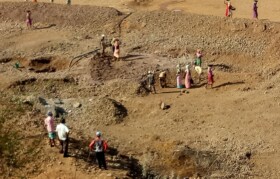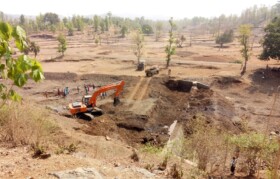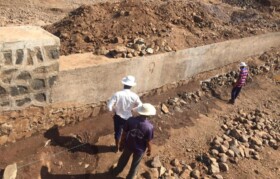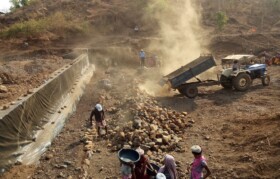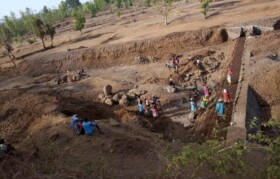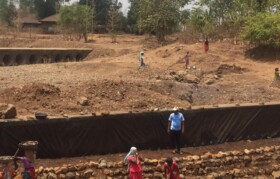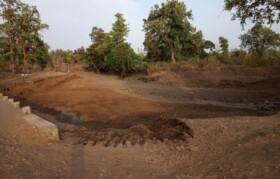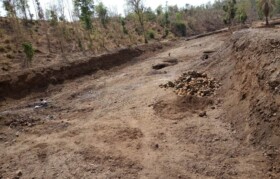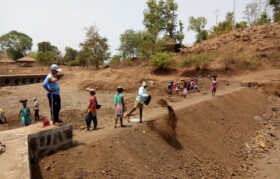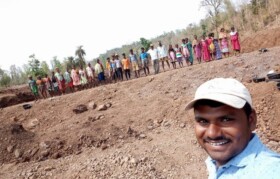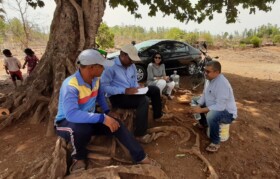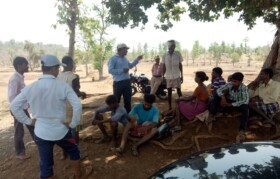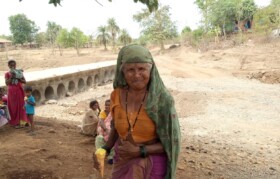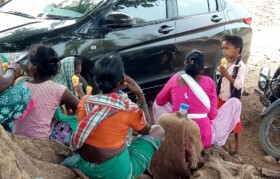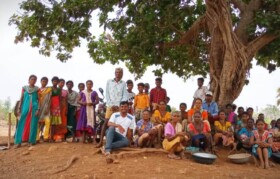May-Jun 2019 Kaspada River De-silting and Check Dam

This post has already been read 1107 times!
As you may already know, we have adapted 10 schools/villages till today in tribal area of Vikramgad in Palghar district, roughly 100km from Mumbai. In this region, there is an average rainfall of upwards of 200 cm in a year which is ideally sufficient if water conservation is done properly. Since water keeps flowing through stream, very little gets percolated into the earth, which results in insufficient recharging. Another reason for under-charging of water is rocky bed under soil (in some regions). Mechanism to slow down the flow of water, deepen the catchment areas and facility to hold water with large heads are required to ensure that a large area gets recharged.
In the absence of substantial water resources, the villagers can’t take more than one crop a year (only rice is taken during the monsoon season). Post this season, to make both the ends meet, they leave their place and go to construction sites, brick kiln or work as labourer on fishing boats. By working on increasing the ground water levels, our objective is to allow the villagers to take multiple crops.
One of the remote villages in the region named Kaspada, approached us for help with their water problems. Their wells dried up almost by end of Feb this year (unlike April in previous years). There is a seasonal river flowing from the village. It experiences flood during main monsoon period, however, it generally dries up by Oct/Nov every year. The same river also recharges wells in monsoon, using which villagers can drag through the entire year for their water needs.
However, last year due to less rain, the rivers could not recharge wells sufficient enough to last for the entire year. One of the additional reason what we noted was lot of silting which gathered in the riverbed. As per villagers, riverbed level, in last 10-15 years, has increased by almost 4-6 feet in different places in the river. This silting, effectively reduced its water storage capacity, reduced permeability of water for recharging of wells and also increased risk of overflows/ floods during heavy rainfall. We reviewed with few experts and villagers and identified 3 places in the river where heavy de-silting is required.
Preparation Phase
The area being in “forest land”, no activity can be carried out without permission from forest department. We worked with forest department to explain them about the challenge faced by villages and urgent need to act on this. We got good support from them. Senior forest officers in Jawhar region agreed and proposed to initiate this project under NREGA scheme of government where villagers would also get paid for doing this work while solving their own problems.
Execution Phase
The project started on 13th May (with around 50 workers coming from hamlets around). The original plan included de-silting at three places in the river and strengthening of existing check dam at two places. De-silting of the first spot along with check dam would be creating large reservoir in the river. This would help recharge wells properly and also create natural reservoir in the river itself for longer duration after monsoon. The work was carried out with manual labour first one week. However, work was slow and had to use machines like forkland, JCB to speed it up to finish before monsoon. Our donors from Mumbai provided us with forkland machine – explicitly shipped from Mumbai to Vikramgad for this purpose.
Project Statistics
| Total person days of effort spent | 905 |
| Total working days | 12Days |
| Forkland used | 8 Days |
| JCB used | 2.5 Days |
| Truck loads of silt removed | 700+ |
Challenges faced & lessons learned
- While some of the villagers had approached us to help them with water crisis, common villager in the village had started adjusting to the water problems – means, they adjust by drinking relatively dirty water fetched digging-up pits in the river bed, or even fetching water from any wells 2-3 km away from their houses. All villagers need to align with the issue of the village and align their priorities on such projects. We still do not see this change.
- The region being rocky few feet under the soil level, water percolation needs to be taken seriously and have to work upon various and regular aspects of conservation – including regular de-silting of river. We need to work on making villagers understand importance of this so that they take it up as a joint social cause of the village themselves without being dependent on any external entity.
- Another important aspect which we noticed and we appreciated was love and respect of tribals for their cattle. In spite of was water being difficult to fetch, whenever cattle was on lookout for water, any villager around would fetch water and offer it to cattle… such a natural and unconditional emotion towards animals.
Project Benefits
Though we call the place as Kaspada, it would help people from at least 4-5 villages (such as Doyapada, Kalampada, Alivpada, Patilpada in the region), roughly around 2500-3000 people. All these places are under group gram panchayat of Vehelpada in Vikramgad. With large excavation and de-silting, this would virtually revive river to its original depth and hopefully solve perennial water problem for the cluster.
This problem is not unique to these villages, but this issue is required to be addressed at large scale in many villages in the river. It is just that they approached and we could do only one at time in our capacity. We, as people living in urban areas, owe it to people in the region (where major lakes supplying water to Mumbai are in this region), but they still suffer from water shortage. For us bucket of water is just flick of a tap, while for same quantity they need to fetch it from 2-3km from other well or to pits dug-up in the river…. requires deeper introspection.
Photo Gallery

